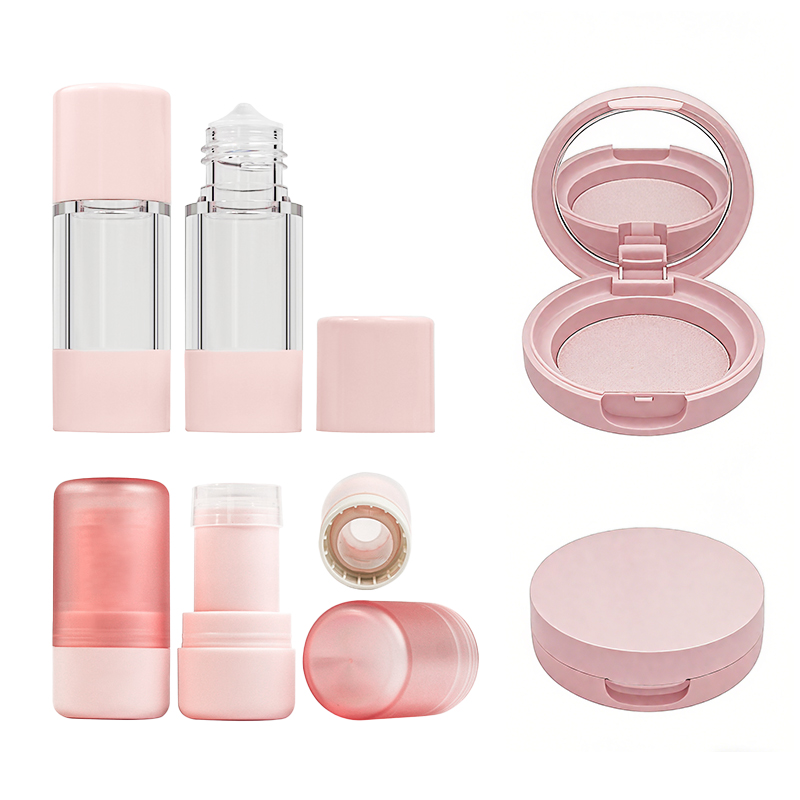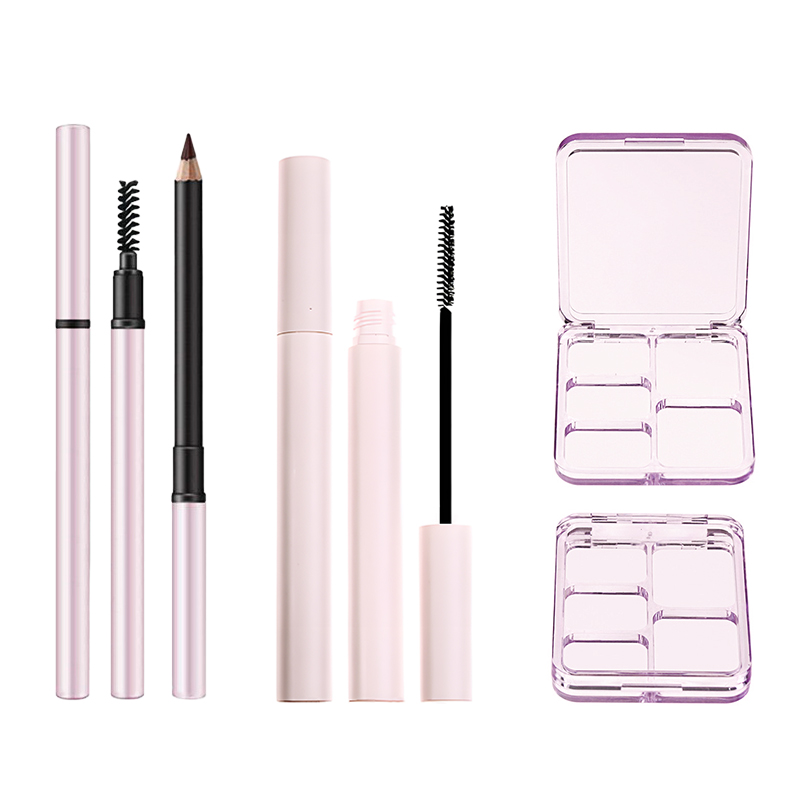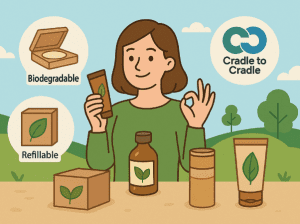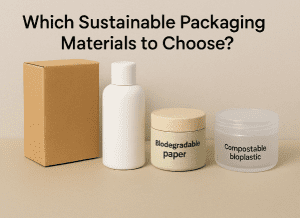Eco Friendly Cosmetic Packaging: A Simple How-To Guide
Eco friendly cosmetic packaging isn’t just a buzzword anymore—it’s the next big move if your brand wants to stay sharp and relevant. Between Gen Z calling out greenwashing on TikTok and retailers pushing for cleaner supply chains, packaging that pollutes is straight-up bad for business. If you’re still wrapping eye creams in plastic clamshells from 2009… we need to talk.
Think of it like this: your packaging isn’t just a box—it’s handshake, storefront, and silent pitch all in one. And when it’s designed right? It cuts costs, earns customer loyalty, and makes you look like the smartest person in the room (without saying a word).
This guide breaks down what works—from refillable compacts to bamboo fiber tubes—so you can scale smart without greenwashing or guesswork. Let’s get into it.
Reading Notes on Eco Friendly Cosmetic Packaging: From Materials to Margins
FSC Certified Paper: Highlight your commitment to sustainability by opting for FSC certified biodegradable paper that reassures conscious consumers.
Refillable Compacts: Reduce landfill waste and elevate brand loyalty with refillable packaging options that customers can reuse.
Cradle to Cradle Logo: Build trust and transparency with eco-conscious shoppers through third-party certifications like Cradle to Cradle.
Laser Etching & Natural Pigments: Enhance visual appeal without harming the planet using laser etching techniques and plant-derived pigments.
Bamboo Fiber Savings: Cut costs while keeping it green—bulk discounts on bamboo fiber make sustainable luxury surprisingly profitable.
5 Powerful Reasons Your Brand Needs Eco-Friendly Cosmetic Packaging Now
There’s no sugarcoating it—shoppers are watching what you wrap your products in. Here’s why switching to greener packaging is a smart move right now.
Showcase Sustainability with FSC Certified Biodegradable Paper
- FSC Certified sources guarantee paper comes from responsibly managed forests. That’s not just good PR—it’s planet-friendly.
- Using biodegradable paper reduces long-term waste and breaks down naturally, unlike plastic-based wraps.
- Beauty brands that highlight sustainability on their labels tend to score higher trust with Gen Z buyers.
- Eco-aware consumers are drawn to recyclable and compostable options, especially when paired with clean product formulas.
Cut Material Waste Using Refillable Compacts
You don’t need to reinvent the wheel—just make it reusable.
- Refillable compacts let buyers keep the case and swap out only the product pan.
- This cuts down on single-use plastics and lowers production costs over time.
- Many brands now offer incentives for returning empty cases—smart move!
- It fits perfectly into a broader push toward eco-friendly cosmetic containers, especially among niche skincare startups.
Attract Eco-Conscious Shoppers via Cradle to Cradle Logo
Eco-savvy buyers aren’t just looking at ingredients—they’re checking logos too.
• The Cradle to Cradle logo signals full-circle sustainability—from material sourcing to end-of-life recyclability.
• Displaying this badge boosts your credibility fast among climate-conscious millennials.
• It also aligns your brand with globally recognized standards for safer, smarter design.
And when customers see that you’re walking the talk? They stick around longer—and spend more doing it.
Enhance Product Appeal with Laser Etching and Natural Pigments
Short bursts of visual flair can change how people perceive your packaging:
– Sleek finishes using laser etching stand out without adding plastic or metallic foils.
– Formulas printed using natural pigments avoid synthetic dyes while still popping on shelves.
– The combo feels luxe but still checks every box for clean beauty fans concerned about toxins or excess waste.
This tiny upgrade can elevate your packaging game without hurting your green goals.
Boost Margins through Bulk Discounts on Bamboo Fiber
Let’s talk numbers—because going green should also mean saving green:
| Material Type | Avg Unit Cost ($) | MOQ Discount (%) | Shelf Life Benefit |
|---|---|---|---|
| Plastic Compact | $0.85 | None | Low |
| Aluminum Tin | $0.95 | Minimal | Medium |
| Recycled PET | $0.78 | Up to 10% | Medium |
| Bamboo Fiber | $0.69 | Up to 25% | High |
By choosing materials like bamboo fiber, brands tap into both lower unit costs at scale and stronger consumer appeal thanks to its biodegradable nature and renewable sourcing story.
Bulk orders don’t just help margins—they help you stay stocked during peak seasons without compromising your sustainability values either.
Which Sustainable Packaging Materials to Choose?
From luxe vibes to compost-ready jars, here’s your cheat sheet on picking packaging that’s kind to the planet without skimping on style.
Recycled Cardboard Benefits and Use Cases
- Recycled cardboard is a go-to for brands wanting eco-conscious vibes without blowing the budget.
- It’s super adaptable—used in boxes, inserts, sleeves—especially popular in cosmetics industry gift sets.
- The material scores high on cost-effectiveness, making it ideal for indie beauty startups.
- Bonus points? It’s lightweight yet offers surprising durability, even when stacked or shipped long distances.
- Customers love the earthy texture—it screams natural while staying sleek.
- Perfect for brands that want their story told through sustainable choices.
Post-Consumer Recycled Plastic Insights
| Material Type | % Virgin Plastic Saved | Common Use | Regulatory Compliance |
|---|---|---|---|
| HDPE PCR | 75% | Bottles | FDA/REACH |
| PET PCR | 60% | Jars | EU Cosmetics Regs |
| PP PCR | 50% | Closures | Prop65 Compliant |
| Mixed PCR | Varies | Tubes | ASTM D7611 |
♻️ Using PCR plastic helps cut down landfill waste and supports circular sourcing.
- Brands switching from virgin materials report up to a 40% drop in carbon footprint—big win.
- Supply chain transparency matters now more than ever; traceable sources are key.
- Regulations are tightening globally, so compliant packaging isn’t optional anymore.
Topfeel taps into this by offering fully certified containers made with high-grade post-consumer blends.
Biodegradable Paper Properties Explained
Biodegradable paper has its own charm:
It breaks down naturally within weeks under the right conditions—no toxic leftovers.
Its base of paper pulp makes it feel familiar yet fresh.
Some types resist water better than others, though don’t expect them to survive a rainstorm unscathed.
Great for things like wraps or inner liners where full moisture resistance isn’t critical but sustainability is front-and-center.
Printability? Solid—but stick with soy-based inks if you’re going all-in on being green.
And yes, it works beautifully as eco labels on small-batch skincare jars.
Compostable Bioplastics: Performance and Lifespan
“By 2025, over 30% of beauty brands will shift toward compostable packaging,” predicts Euromonitor International.
→ Step 1: Choose bioplastics made from corn starch or sugarcane—they break down fast under industrial composting conditions.
→ Step 2: Match product lifespan with material lifespan—these work best for short-shelf-life items like masks or testers.
→ Step 3: Educate customers! If they toss it in regular trash instead of compost bins, the benefits vanish fast.
These materials shine when used in smaller formats like sample-size cosmetic jars, where performance meets purpose without excess waste.
Their limited lifespan is a feature, not a flaw—it encourages conscious consumption habits while delivering solid functional value during use.
Bamboo Fiber Characteristics for Luxury Brands
You want premium feel and green creds? Enter bamboo fiber:
• It’s a naturally renewable resource, growing crazy-fast without pesticides or fertilizers. That alone makes it an eco darling in upscale circles.
• The texture? Smooth as silk but still earthy—a rare combo that screams sophistication while staying grounded in nature.
Paired with minimalist design, bamboo hits all the right notes for luxury skincare lines aiming at sustainability-savvy shoppers.
From applicators to compact cases, its lightness doesn’t sacrifice strength thanks to built-in durability factors unique to plant-based fibers.
And hey—it just looks good sitting on your vanity shelf too.
4 Steps to Design Eco-Friendly Cosmetic Packaging
Want your beauty brand to go greener without losing its cool factor? These four smart moves walk you through how to rethink your packaging game with a more earth-conscious twist.
Step 1 – Evaluate Material Options Like Post-Consumer Recycled Plastic
When it comes to picking better packaging materials, not all “green” choices are created equal. Here’s how you can cut through the noise:
• Choose post-consumer recycled plastic (PCR) when possible—it reduces landfill waste and lowers carbon emissions.
• Weigh the environmental impact of glass, bio-resins, and aluminum alternatives. Some may look eco but come with hidden costs.
• Balance shelf appeal with recyclability; think transparent PCR PET instead of virgin plastic for clarity and sustainability.
• Always consider sourcing—local materials usually mean lower transport emissions.
The key here? Don’t just follow trends—study what actually works long-term for both the planet and your supply chain.
Step 2 – Prototype with Mono-material Bottles for Easy Recycling
Creating a prototype isn’t just about aesthetics—it’s where design meets real-world recycling systems.
⦿ Stick with mono-material bottles, especially HDPE or PET, since they’re widely accepted by recycling facilities across regions.
⦿ Avoid mixing materials like pumps made from metal springs inside plastic bodies—they often get rejected during sorting processes.
⦿ Use clear labels or direct printing techniques that don’t interfere with recyclability ratings.
In fact, a 2024 report by the Ellen MacArthur Foundation highlights that mono-material designs increase actual recycling rates by up to 32% compared to mixed-material formats.
Step 3 – Apply Water-based Coatings and Soy-based Inks
This step is all about reducing toxicity while keeping your packaging looking sharp.
You’ll want to swap out traditional solvent-heavy finishes for more sustainable ones like:
• Water-based coatings – These emit fewer VOCs and still offer solid moisture resistance without harming marine life if they leach out.
• Soy-based inks – Made from renewable crops, these inks break down faster than petroleum-based options and give vibrant print quality.
• Matte finishes using eco varnishes – Perfect for that luxury feel without the chemical baggage.
• Minimalist graphics – Less ink = less waste = cleaner production cycles.
Together, these tweaks make your packaging feel premium while staying true to your low-impact goals.
Step 4 – Verify GOTS Certification for Your Packaging
Getting certified isn’t just red tape—it’s proof you’re walking the talk when it comes to sustainability standards.
GOTS (Global Organic Textile Standard) doesn’t only apply to clothing; it also covers things like cotton pouches, wraps, or labels used in cosmetic kits. To meet their criteria:
• Ensure all textile components are made from organically grown fibers.
• Confirm no harmful chemicals were used during processing.
• Audit working conditions along the supply chain—yes, labor ethics count too!
• Keep documentation ready for third-party verification annually.
Once you’re GOTS-certified, you’ve got bragging rights—and consumer trust—to back up every eco claim on your label. Even Topfeel uses GOTS-compliant material blends across some of their limited-edition lines now.
Plastic Vs. Glass: Best Cosmetic Packaging
Choosing between plastic and glass for beauty packaging isn’t just about looks—it’s about durability, weight, recyclability, and your brand’s vibe.
Plastic
Plastic has a bad rap sometimes, but it’s not all doom and gloom. When done right, it’s actually a smart move for sustainable beauty packaging.
• Lightweight design makes it ideal for travel-friendly products and reduces shipping emissions.
• Options like PET and HDPE are widely accepted by recycling facilities across the globe.
• Lower manufacturing costs make plastic a go-to for startups looking to scale without breaking the bank.
• It’s tough—its durability means fewer breakages during transport or on retail shelves.
Now let’s be real—plastic isn’t perfect. But eco-conscious advances like refillable systems and biodegradable blends are shaking things up. Brands aiming to reduce their overall carbon footprint can explore post-consumer recycled plastics as an alternative to virgin materials.
According to Euromonitor International’s Q2 report from early 2024, “Over 60% of Gen Z consumers factor recyclability into their cosmetic purchase decisions,” showing how vital sustainable choices have become.
Short-tail variations used: eco, friendly packaging, cosmetic wrap
Glass
Glass is where style meets sustainability—but it’s not always the most practical option depending on your product goals.
- It gives off that unmistakable premium feel, making it perfect for high-end skincare lines.
- Being chemically inert, it doesn’t interact with formulas—a win for ingredient integrity.
- Glass is endlessly recyclable, unlike some plastics that degrade after multiple uses.
- The visual appeal? Unmatched—the clarity alone elevates shelf presence.
But there’s a trade-off:
– It’s heavier than plastic, which means higher shipping costs and more fuel consumption during transit.
– More prone to damage due to its fragile nature—even minor drops can mean shattered dreams…and containers.
For luxury brands prioritizing aesthetics over convenience, glass remains unmatched despite its higher manufacturing cost and fragility risks.
Short-tail variations used: eco wrap, cosmetic container, friendly material
Struggling with Packaging Costs? Try Biodegradable Solutions Now
Cutting costs on packaging doesn’t have to mean cutting corners. Smart moves with biodegradable materials can keep your brand green and your wallet happy.
Negotiate Wholesale Pricing on Compostable Bioplastics
- Locking in wholesale pricing is all about timing and volume—order consistently, not just in bulk.
- Partner with suppliers who offer transparency in their supplier negotiation process.
- Ask for tiered pricing based on order frequency, not just quantity.
- Always compare rates across regions; international suppliers might offer better deals on compostable bioplastics.
A little back-and-forth can go a long way when you’re trying to cut down packaging spend without ditching your eco goals. Get chatty with vendors—you’d be surprised what kind of deals pop up when you actually ask.
Optimize Volume Manufacturing of Biodegradable Paper
| Process Type | Avg. Cost/Unit | Output Rate/hr | Waste Reduction (%) |
|---|---|---|---|
| Manual Assembly | $0.42 | 100 | 8% |
| Semi-Automated | $0.26 | 280 | 18% |
| Fully Automated | $0.19 | 520 | 25% |
Switching to automated systems can seriously boost your game in volume manufacturing of biodegradable paper. The numbers don’t lie—higher output and lower waste equal real savings over time. If you’re still hand-folding boxes or sleeves, it’s probably time to rethink that setup.
Secure Contract Packaging for Seed Paper Solutions
• Don’t sleep on the benefits of outsourcing your contract packaging, especially if you’re scaling fast.
• With seed paper, precision matters—outsourced facilities often have better tech for embedding seeds evenly into pulp.
• Look for partners who specialize in eco-friendly solutions, not just generic packing lines.
• You’ll save space, time, and labor while still delivering premium sustainable vibes through custom-designed seed inserts.
Outsourcing isn’t giving up control—it’s gaining efficiency where it counts most.
Maximize Savings with Bulk Discounts on Bamboo Fiber
Small brands often overlook how much they can save by bundling orders across SKUs using the same core material like bamboo fiber. According to the April 2024 Sustainable Materials Index, businesses that consolidated their fiber-based packaging into fewer formats saved an average of 21% annually through smart volume purchasing and stacked bulk discounts.
You don’t need a warehouse full of shipping boxes—just a plan that works smarter around fewer shapes and sizes made from consistent materials like bamboo pulp sheets or molded trays.
One-time big buys might sting upfront but pay off fast—and Topfeel’s got options that scale with you as you grow without blowing out the budget or the planet.
FAQs
It starts with choosing materials that feel good in your hands and sit right on your conscience. Some of the most trusted options include:
- Bamboo Fiber – smooth, strong, and naturally elegant; it signals care from the very first touch.
- Recycled Cardboard – lightweight yet sturdy, perfect for brands that want to keep things minimal but meaningful.
- Post-Consumer Recycled Plastic (PCR) – gives discarded plastic a second life while reducing demand for new resources.
Each of these choices carries its own story—and when you’re producing at scale, those stories matter.
Refillables do more than cut down on single-use plastics—they build loyalty. A beautifully designed compact becomes part of someone’s daily ritual, something they reach for again and again. Instead of tossing out an entire unit every time product runs low, users simply replace the core insert—less trash, less guilt…and fewer raw materials needed over time.
For brands scaling up sustainably, this model also means reduced production costs per customer over months or years—not just weeks.
Mono-material designs aren’t just smart—they’re honest. Here’s why many conscious creators prefer them:
- They simplify recycling—no need to separate parts or guess what goes where.
- Local facilities are more likely to accept them without issue.
- When paired with water-based inks or soy pigments, they stay clean inside and out.
The result is clarity—for both consumers and recyclers alike.
Yes—but not just yes like a checkbox answer; yes as in “this could change everything.” Contract packagers familiar with biodegradable formats can take your seed paper dreams from concept sketch to full-scale rollout without draining internal teams dry.
They already know how delicate these papers are…how moisture matters…how ink bleeds if you push too hard too fast. With their support behind you, growing sustainable impact becomes less guesswork—and more growth strategy made real.







